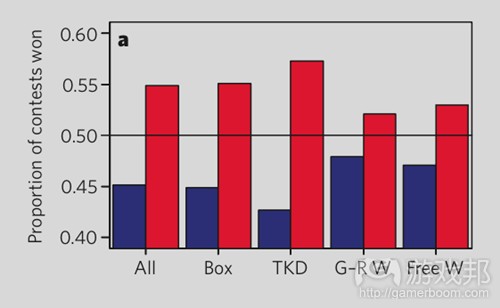红色vs蓝色:谈颜色选择对游戏竞技结果的可能影响
作者:Jamie Madigan
象棋拥有自己的“黑vs白”的颜色方案,而对于电子游戏来说通常都是“红vs蓝”。这是你在许多游戏中能够看到的一种比赛,不管是关于你的角色的颜色,他们的头上所呈现的颜色,亦或者同时包含了这两种情况。有时候你会随机被分配给一支团队,也有时候你可以自己做出选择。那么选择红色或蓝色会具有什么优势吗?
也许会有一点。
我刚看完Adam Alter的《Drunk Tank Pink and Other Unexpected Forces That Shape How We Think, Feel, and Behave》。其中有一章节讨论了在竞技性运动中制服颜色对于比赛的影响。作者引用了2005年对于参加了拳击,跆拳道,古典式摔跤和自由式摔跤等奥运会选手的研究。奥运会规定竞争双方将随机被分配穿上蓝色服装和红色服装。因此这便是关于制服对表现状况的影响的一个天然实验台。
研究人员发现,那些穿上红色制服的人赢得比赛的情况更多:
根据Hill和Barton的理论(同时也是Adam Alter的理论),红色代表着更高的侵略性,支配性以及睾丸激素激增。当人或动物表现出积极进攻的行为时,脸或皮肤便会变红。我知道,这听起来似乎与人类参与体育运动的主题有点偏离,但其理念只是关于穿红色服装的人会更具侵略性。看到红色脑子里会更快出现关于这些概念的想法。在像拳击或跆拳道等需要侵略性的比赛中,这便更加重要。研究者认为,穿上红色服装能让你变得更加兴奋并且更容易幻想最后的胜利。而穿上蓝色服装的竞争者可能会因为认为穿着红色衣服的对手变得更加可怕而受到影响。这都是一些潜意识的想法。但却是事实。
而运动员并不是唯一受到颜色影响的对象。我们还可以列举另外一个例子,即裁判是如何基于同样的原理受到影响。在研究中,专业的跆拳道裁判会通过观看红蓝选手的记录做出评判。根据世界跆拳道联合会的官方规则,裁判会给予特定动作奖励分数。这里存在一个诀窍:面对一半的裁判,研究人员改变了镜头去交换运动员制服上的红色/蓝色。所以其他裁判看到的镜头将会是一样的,除了蓝色选手变成红色,反之亦然。
结果怎样?两边的裁判都把更多分数给了那些穿红色制服的运动员。如此看来制服颜色影响着裁判们对于选手表现的判断,因为他们潜意识地认为那些穿红衣服的人更具攻击性。这并非关于制服颜色的首次研究。让我们回到20世纪80年代,Mark Frank和Thomas Gilovich便曾着眼于全球橄榄球联赛和美国冰球联盟中身穿黑色制服球队所接受的罚球数量。他们发现裁判会更频繁地发现穿黑色球服(游戏邦注:这一颜色通常都会让人联想到邪恶)那一队的犯规行为。
那么电子游戏中的情况是否也是如此呢?至少有时候也是这样的。杂志《Cyberpsychology & Behavior》公布了2008年的一项研究以及来自《虚幻竞技场2004》中的1347场比赛的数据。他们发现红色的队伍比蓝色队伍的获胜率多出5%,而这一数值远高于你所认为的侥幸。
在这里需要注意的是:这种所谓的“红色”效应并不是任何密切竞争中获胜的决定性元素。Hill和Barton在2004年的研究便证实了这一点:当竞争中被分配错时(如一名重量级拳击选手被分配到中量级比赛中),这种穿制服的优势也就不见了。同样的,专业玩家也不会因为被分配到蓝色队伍而遭遇失败。
所以当你在电子游戏中能够做出选择时你是否应该转向红色队伍呢?为此我们还需要进行更多的研究,但在其它条件不变的情况下这些研究都表示选择红色是无害的。它甚至还能带给你一定的帮助。
(本文为游戏邦/gamerboom.com编译,拒绝任何不保留版权的转发,如需转载请联系:游戏邦)
Red vs. Blue: Which Team Should You Choose?
by Jamie Madigan
Chess may have its “black vs. white” color scheme, but for video games it’s often “red vs. blue.” It’s the kind of matchup that you find in dozens of games once you go looking for it, whether it’s the color of your avatar, the heads up display, or both. Sometimes you’re randomly assigned to a team when you join, but other times you can choose. Is there any advantage to picking red? Or blue?
Yes. Well, maybe. A bit.
I just finished reading the book Drunk Tank Pink and Other Unexpected Forces That Shape How We Think, Feel, and Behave by Adam Alter. One chapter deals with how the color of a uniform can affect performance in a competitive sport. Alter cites a 2005 study that looked at Olympic athletes participating in one-on-one “combat sports” like boxing, tae kwon do, Greco-Roman wrestling, and freestyle wrestling. The rules of the Olympics stipulate that one competetor is randomly assigned a blue outfit while the other gets red. Thus it was a great opportunity for a natural experiment on the effects of uniform color on performance.
The researchers found that those wearing red uniforms won a statistically significantly larger portion of their matches:
Hill and Barton’s theory (which is also Drunk Tank Pink author Adam Alter’s theory) is that throughout nature the color red is associated with heightened agression, dominance, and testosterone levels (think mating season and/or fighting season). Skin gets flushed and animals display the red bits of their bodies while engaging in dominant and aggressive behavior. I know; it sounds a bit far fetched in the context of humans participating in sports, but the idea is simply that wearing the color red primes competitors to think more about being particularly aggressive and dominating. That is, it makes thoughts about those concepts come to mind quicker and more easily. In sports like boxing or tae kwon do where agression makes you more competitive, this matters. Wearing red, the researchers argue, essentially makes it just a little easier for you to get pumped up and visualize the kind of behavior that wins bouts. And the competitor in blue might compound the effect by perceiving his/her red opponent as more intimidating or imposing. This might even all be subconscious. Probably is, in fact.
And the athletes aren’t the only ones affected. Alter also cites another study that showed how referees can be affected by the same principle. In the study, professional tae kwon do referees watched recordings of red and blue competitors trying to knock the stuffing out of each other. Per the official rules of the World Taekwondo Federation, the referees awarded points to specific types of blows. Here’s the trick, though: for half of the referees, the researchers digitally altered the footage to swap the red/blue colors on the athletes’ uniforms. So the footage was exactly the same as that seen by the other referees, except that blue competitors were now the red and vice versa.
The result? Both sets of referees gave more points on average to those athletes in red uniforms and less to those in blue. The color of the uniform affected their judgement independent of their performance, presumably because it tapped in to some unconscious bias the judges had for thinking that someone in red was more agressive and more dominating. This wasn’t the first study on uniform color, either. Back in the 1980s Mark Frank and Thomas Gilovich looked at the number of penalties earned by teams in the National Football League and National Hockey League that wore black uniforms. They found that those wearing black –a color typically associated with the wardrobes of the villainous– were found by referees to be more guilty of infractions, fouls, and rule violations relative to those wearing light colored jerseys.
Does the same thing happen in video games? Sometimes, at least. One 2008 study published in the journal Cyberpsychology & Behavior scraped data from 1,347 Unreal Tournament 2004 matches. (Why they didn’t stop at 1,337 for an awesome in-joke I can’t imagine. I MEAN COME ON.) They found that red teams won about 5% more matches than blue, which is far more than you would expect from chance alone.
There is a caveat to this, though: this “seeing red” effect isn’t huge and won’t be the deciding factor in anything but a very close competition. The 2004 study by Hill & Barton confirmed this: when competitors were mismatched (such as a a heavyweight boxer wailing on a middleweight) the advantage afforded by wearing a red uniform went away. Similarly, a pro gamer isn’t goint to lose to a scrub simply because she was randomly assigned to Blue.
So should you pick the red team when in a video game when you have the choice? More research on games is needed, but all else being equal these studies suggest it couldn’t hurt. It might help, actually.(source:gamasutra)









































 闽公网安备35020302001549号
闽公网安备35020302001549号